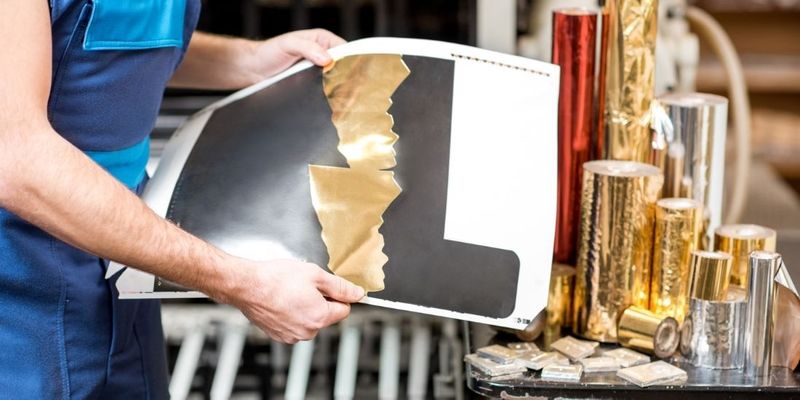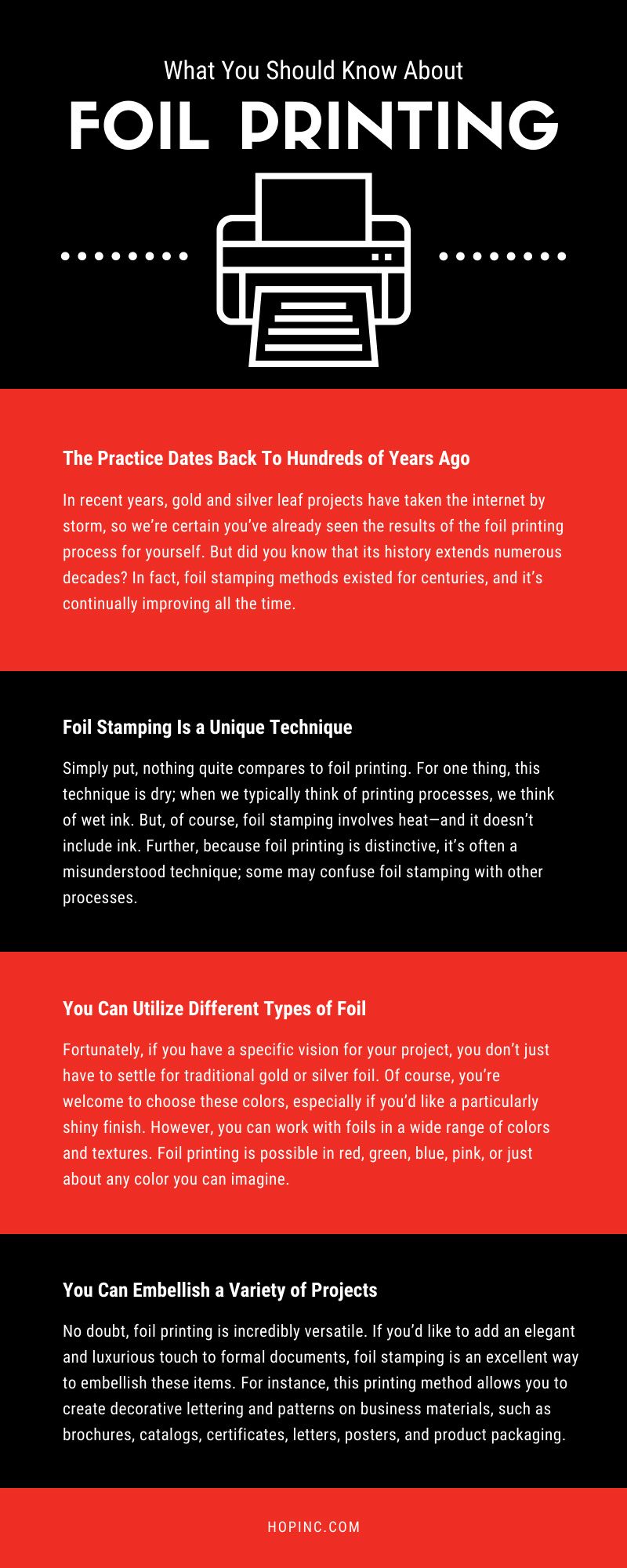Foil printing, or foil stamping, is a specialty printing method that involves using heat and pressure to apply metallic or pigmented foil to paper. If you’re curious as to what you should know about foil printing, we put together a comprehensive guide for you. Continue reading for some fascinating insight into all aspects of this interesting printing process.

What You Should Know About Foil Printing
The Practice Dates Back To Hundreds of Years Ago
In recent years, gold and silver leaf projects have taken the internet by storm, so we’re certain you’ve already seen the results of the foil printing process for yourself. But did you know that its history extends numerous decades? In fact, foil stamping methods existed for centuries, and it’s continually improving all the time.
At first, many artisans would create gilded leather book covers from real gold leaf to achieve a more aesthetically prestigious effect. In terms of the process itself, foil printing was simply a manual process, so it required much more effort; craftspeople would have to beat gold leaf by hand. Plus, at the time, the necessary materials were expensive, so this type of artwork was inaccessible for many people. Over the years, however, the labor-intensive foil work transitioned into traditional hot foiling. Companies figured out how they could manufacture efficient printing machines to accommodate a multitude of formats. The entire hot foil printing process entails a heated metal die to bond a thin layer of foil to a substrate. First, the requested design is etched into a metal die. Then, the die is heated up and pressed into the project. The heat activates the foil film, and the foil fuses into the project—in other words, the foil’s release is essentially what acts as the glue for the substrate. Thankfully, the hot foil process became less costly since people could craft the foil from aluminum or tin. Today, dozens of companies—such as House of Printing—now prioritize digital foil printing to create smooth, vibrant designs. Instead of stamps, printers can quickly recreate the same sought-after foil effect via computer files. Like hot foiling, digital foil stamping isn’t as pricey as the earlier methods.
Foil Stamping Is a Unique Technique
Simply put, nothing quite compares to foil printing. For one thing, this technique is dry; when we typically think of printing processes, we think of wet ink. But, of course, foil stamping involves heat—and it doesn’t include ink. Further, because foil printing is distinctive, it’s often a misunderstood technique; some may confuse foil stamping with other processes. For example, while embossing may seem similar, the process involves two dies on each side of the substrate instead of one. Also, embossing significantly changes a substrate’s surface—at least when compared to foil stamping. Embossing creates a “raised” effect, but foil stamping is still flat—the foil itself is what produces the illusion of depth. Thus, embossing and foil printing complement each other, but the methods are not identical.
Finally, the results from foil printing are truly captivating; not all printing techniques can produce visually and tactically appealing products. You need to be cautious in some instances, though; although foil printing offers seemingly endless possibilities, you’ll need to consider the type of paper you’d like to use. After all, you want to make sure the foil designs or lettering are easy to read, so you’ll need to select colors wisely. Further, small fonts or shapes may not be legible once they bond to your substrate—for the foil design to remain unbroken, it’s best to avoid thin lines when you create a design. Otherwise, your design may not adhere properly to the paper.
You Can Utilize Different Types of Foil
Fortunately, if you have a specific vision for your project, you don’t just have to settle for traditional gold or silver foil. Of course, you’re welcome to choose these colors, especially if you’d like a particularly shiny finish. However, you can work with foils in a wide range of colors and textures. Foil printing is possible in red, green, blue, pink, or just about any color you can imagine. In addition, you can choose to experiment with glitter foils, holographic foils, pearlescent foils, or pigment foils. When it comes to textures, you can opt for dull—or matte—foils as well as foils in gloss or satin finishes. No matter what foil you choose, we’re certain you’ll have a one-of-a-kind product in the end.
You Can Embellish a Variety of Projects
No doubt, foil printing is incredibly versatile. If you’d like to add an elegant and luxurious touch to formal documents, foil stamping is an excellent way to embellish these items. For instance, this printing method allows you to create decorative lettering and patterns on business materials, such as brochures, catalogs, certificates, letters, posters, and product packaging. Additionally, foil printing is suitable for supplies to market yourself; consider personalized business cards or envelopes. First impressions are everything, and you can make good ones through thoughtfully planned paper goods. On the other hand, if you want exquisite accents on personal paper products—think invitations, greeting cards, postcards, and stationary—foil stamping is a popular method as well. You can easily capture recipients’ attention with the shimmering foil and an added pop of color.
Interested in utilizing foil stamping for your next project? Contact House of Printing, your trusted, full-service print shop. For over four decades, we’ve served the Washington, D.C., and Baltimore area. We’re proud to say that we can even offer a printing method like digital foil printing, as it’s so innovative and versatile. Through this service, as well as our other printing techniques, we can produce artwork of superior quality. We’re passionate about our customers and the custom pieces they wish to create. Our experienced team will do whatever it takes to make your ideas come to life. To get started, visit the shop in Burtonsville or request samples or a quote for your project online. We offer free delivery to our local customers, but even if you don’t reside in the area, we’d be happy to help you; we treat every project with the utmost attention to detail.

